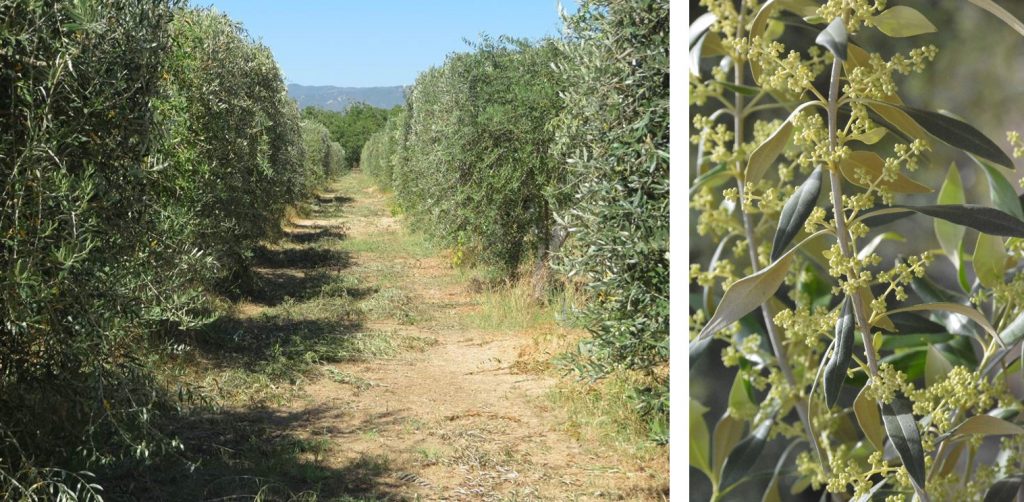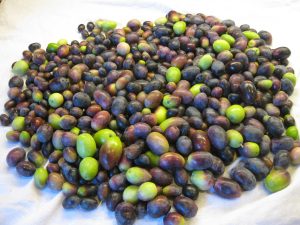Olive Collection
Jenny Smith, USDA-ARS National Clonal Germplasm Repository, One Shields Drive, University of California, Davis, California 95616
Gayle M. Volk, USDA-ARS National Laboratory for Genetic Resources Preservation, 1111 S. Mason St., Fort Collins, Colorado 80521
Emma Balunek, USDA-ARS National Laboratory for Genetic Resources Preservation, 1111 S. Mason St., Fort Collins, Colorado 80521
John E. Preece, USDA-ARS National Clonal Germplasm Repository, One Shields Drive, University of California, Davis, California 95616
Outline
1. Introduction
Olives (Olea) are part of the Oleaceae family. The commercially important species is Olea europaea L. and the most widely grown cultivar is ‘Manzanillo’. Other important cultivars for table olives include ‘Sevillano’, ‘Mission’, ‘Ascolano’, and ‘Barouni’ (Molinar, 2013). Some olive cultivars are preferred for olive oil, table olives, or both. The olive fruit can be harvested at any stage from green olives, olives turning color, and black olives. There are many ways to convert olive fruit into table olives, but the “natural” method is popular in Italy; for this method, olives are washed with water or a weak brine solution and then are preserved in a brine solution, in which they undergo lactic fermentation. This natural method preserves the table olive’s antioxidants and nutritional value (OP Latium, 2018). Curing olives leaches out the oleuropein, a bitter tasting compound that makes freshly harvested olives inedible. Olive oil production has a few more steps because the oil must be extracted from the olives. The first step is to clean the olive fruit. Next, the olives are ground into a paste in order to tear the flesh cells to help release the oil. Then the paste is mixed for 20 to 45 minutes to allow the oil droplets to combine into larger droplets. Finally, a centrifuge is used to separate the oil from the vegetable water and solids (The Olive Oil Source, 2020).
Olives were produced on 37,500 acres in the United States in 2019. The production was valued at over $130 million (USDA NASS, 2020). California is the only state that grows olives, and while it is an important crop, it is dwarfed by Spain’s olive industry. In 2002, Spain grew olives on over 5.6 million acres (Molinar, 2013). California produces 400,000 gallons of olive oil each year. Experts predict that olive oil production in California will continue to increase substantially. The increase will be in part due to larger, highly dense plantings of new olive cultivars that can withstand machines that can efficiently harvest olives (Molinar, 2013).
2. olea (olive) collection
The U.S. National Plant Germplasm System olive collection has 164 accessions of Olea europea that are maintained as trees in the field.

Figure 1. The U.S. National Plant Germplasm System olive collection is maintained as trees in the field (left). An olive tree branch with flowers is shown (right). Photo credit: Gayle Volk.

Figure 2. Diversity in olive fruit (right). Photo credit: John Preece.
Video 1. Dr. John Preece discusses the olive collection.
3. references
USDA National Agricultural Statistics Service (NASS). 2020. Noncitrus Fruits and Nuts 2019 Summary.
Molinar R. 2013. Growing Olives – Information. UC Cooperative Extension Fresno. https://ucanr.edu/sites/Olive_Production/files/175286.pdf
OP Latium. 2018. The Production of Table Olives. OP Latium. http://www.oplatium.it/eng/articles/production-of-olives-and-oil/the-production-of-table-olives/204/
The Olive Oil Source. 2020. Extraction Process. https://www.oliveoilsource.com/page/extraction-process
4. additional information
Curator: Jenny Smith, USDA-ARS National Clonal Germplasm Repository, One Shields Drive, University of California, Davis, CA 95616-8607, jenny.smith@usda.gov
5. Acknowledgments
Citation: Smith J, Volk GM, Balunek E, Preece JE. 2021. Olive collection. In: Volk GM, Preece JE (Ed.) Field tour of the USDA National Clonal Germplasm Repository for Tree Fruit, Nut Crops, and Grapes in Davis, California. Fort Collins, Colorado: Colorado State University. Date accessed. Available from: https://colostate.pressbooks.pub/davisrepositoryfieldtour/chapter/olives/
This training module was made possible in part by funding from USDA-ARS, Colorado State University, and the United States Agency for International Development (USAID).
Editors: Emma Balunek, Gayle Volk, Katheryn Chen
This project was funded in part by the National Academy of Sciences (NAS) and USAID, and any opinions, findings, conclusions, or recommendations expressed in such are those of the authors alone, and do not necessarily reflect the views of USAID or NAS. USDA is an equal opportunity provider and employer. Mention of trade names or commercial products in this article is solely for the purpose of providing specific information and does not imply recommendation or endorsement by the US Department of Agriculture.


